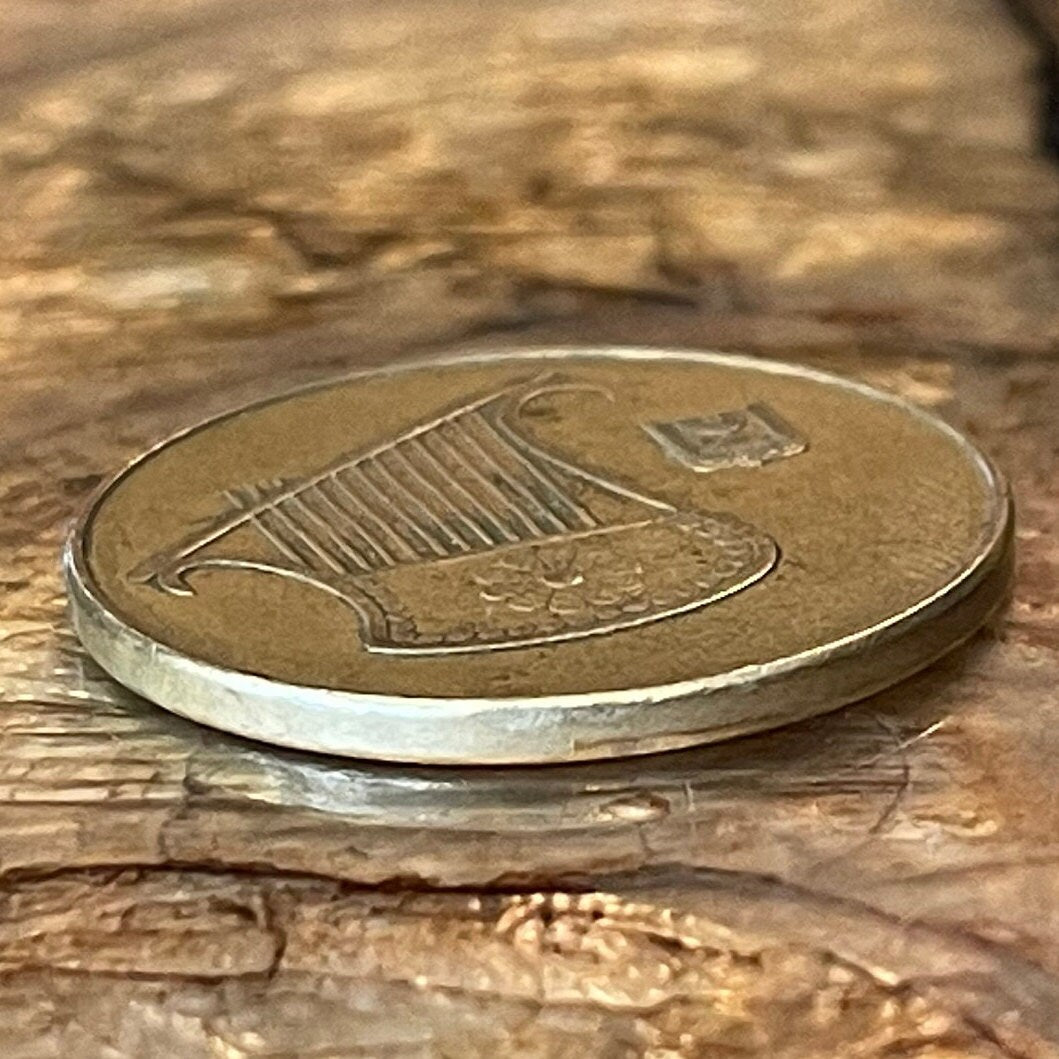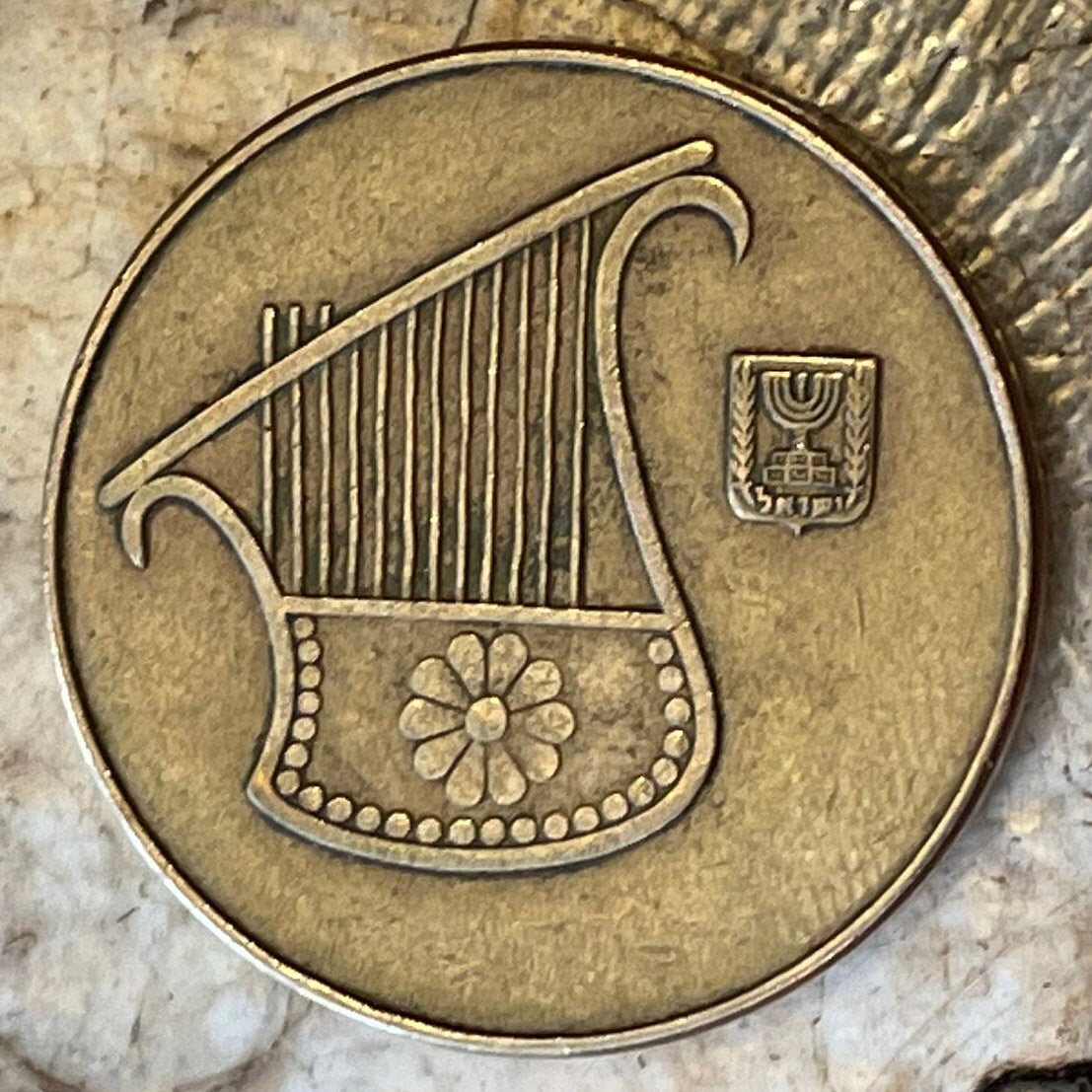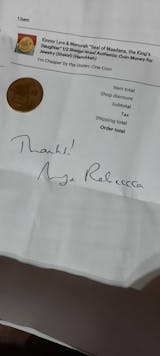elemintalshop
Kinnor Lyre & Menorah "Seal of Maadana, the King's Daughter" 1/2 Sheqel Israel Authentic Coin Money for Jewelry (Shekel) (Hanukkah)
Kinnor Lyre & Menorah "Seal of Maadana, the King's Daughter" 1/2 Sheqel Israel Authentic Coin Money for Jewelry (Shekel) (Hanukkah)
Couldn't load pickup availability
Kinnor Lyre & Menorah "Seal of Maadana, the King's Daughter" 1/2 Sheqel Israel Authentic Coin Money for Jewelry and Craft Making (Shekel) (Hanukkah)
CONDITION: CIRCULATED
Commemorative issue: Hanukkah
Obverse: A lyre. And, a menorah, which is the emblem of the State of Israel. -- The Lyre is based on an ancient (or...possibly forged...see article below) Hebrew seal with the inscription "Maadana, the King's daughter".
Lettering: ישראל
Translation: Israel
Reverse: The denomination "1/2 New Sheqel" in Hebrew and English; the date in Hebrew; "Israel" in Hebrew, Arabic and English; with the word "Hanukka" in Hebrew and English separated by a tiny candelabrum.
Lettering: اسرائيل • ISRAEL התשנ׳׳ה ישראל
1/2
שקל
חדש
NEW SHEQEL
HANUKKA חנוכה
Features
Issuer Israel
Period State of Israel (1948-date)
Type Circulating commemorative coin
Years 5746-5770 (1985-2010)
Calendar Hebrew
Value 1/2 New Sheqel
0.5 ILS = 0.16 USD
Currency New Shekel (1986-date)
Composition Aluminium-bronze
Weight 6.5 g
Diameter 26 mm
Thickness 1.73 mm
Shape Round
Orientation Medal alignment ↑↑
Number N# 7079
References KM# 174
Source: https://www.haaretz.com/archaeology/.premium-why-fake-musical-instrument-on-half-shekel-coin-1.5419091
Why Is There Still a Fake Musical Instrument on the Half-shekel Coin?
Lyre or liar? Archaeologists increasingly think stone seal on which the image is based is a forgery.
In 1979 the Israeli archaeological community was in uproar: Archaeologist Nahman Avigad publicized the existence of a stone seal bearing an inscription in ancient Hebrew. The seal was dated to the seventh century BCE Kingdom of Judea, and the inscription read: “Belonging to Maadana, daughter of the king.”
Above the inscription was a musical instrument identified as a “kinnor,” or lyre, which is familiar from the Bible as King David’s instrument. Avigad determined that this was probably the first glimpse of the legendary instrument used in the Temple.
The excitement was reflected six years later, when the Bank of Israel minted the shape of the lyre (which looks like a harp) on the new half-shekel coin, which was minted in 1985. The lyre is engraved on half-shekel coins to this day, and can be found in wallets everywhere in the country.
The problem is that it is almost certain that this is a forged seal, which portrays an imaginary musical instrument that nobody ever held or played. Doubts about the authenticity of the seal were raised even before the coin was minted, but the Bank of Israel ignored them. The doubts increased over the years and today there is almost a consensus among scholars that it’s a forgery. The central bank insists that there is no reason to replace the coin.
On Wednesday the American magazine The New Republic published a major study by Daniel Estrin on the history of the seal and the lyre on the half-shekel coin.
The half shekel is not a unique coin. All Israeli coins bear ancient images drawn from ancient coins and seals.
“It’s a very clear message, that there’s a straight line connecting ancient and contemporary Israel, it’s proof that Jews were here and have a right to be here,” says Estrin, who published the study after working on it for about two and a half years.
The seal “belonging to Maadana, the daughter of the king” became famous shortly after the late antiquities collector Dr. Reuben Hecht purchased it in the antiquities market in Jerusalem. Like many antiquities whose authenticity is in doubt, the seal was not found in a controlled excavation but ended up in the antiquities market. About two years after the purchase, in 1980, Hecht donated the seal to the Israel Museum in Jerusalem. The seal was on display there until 1993.
And then quietly, without any announcement, it was removed from the exhibition due to the growing doubts as to its authenticity. But the fact that Avigad, one of Israel’s preeminent archaeologists, had no doubt about the seal’s authenticity contributed to the Bank of Israel’s decision to continue to distribute the coin, although doubts had been raised even earlier.
The first to express doubt was Bathja Bayer, a musicologist from the Hebrew University of Jerusalem and an expert on ancient musical instruments. Bayer raised several arguments against the authenticity of the lyre. First of all, she claimed that its structure wasn’t logical, and that if someone had attempted to play it the instrument would have collapsed the first time it was tuned.
Another matter is the fact that it has 12 strings, which is not commensurate with our knowledge about musical instruments during that period. Although the Jewish historian Josephus Flavius describes David’s lyre as having 12 strings, Josephus lived 700 years after the seal was ostensibly created.
Another problem raised by Bayer is that in the early depictions of musical instruments there is always a musician next to the instrument, rather than the instrument appearing on its own. Another problem, she said, is that identifying a woman (Maadana, the king’s daughter) with a musical instrument is problematic, since at the time a woman playing an instrument would have been considered a prostitute, an image that does not suit a princess.
Growing doubts
In the National Library in Jerusalem Estrin found Bayer’s archive, and in it a letter she wrote to the Bank of Israel in August 1985, when the coins had already been minted but had not yet been released to the market. “Regrettably, until now Prof. Avigad has refused to allow me to bring him my arguments,” she wrote. “I turned to him twice and he replied that the opinion of a musicologist didn’t seem to him worthy of consideration here. For many reasons the distribution of the above [coins] should be restricted to the required minimum in order to meet the immediate need. This need is to cancel production of the coin ... that shows the image of the seal.”
“On the one hand the Bank of Israel has Bayer, an expert musicologist from the Hebrew University, who is issuing a warning,” says Estrin. “On the other hand they have the giant Nahman Avigad, so they decide to carry on as usual and to distribute the coin.”
Over the years Bayer continued to give lectures about her doubts, and they gradually infiltrated the scientific community. Estrin spoke to many experts, including Prof. Benjamin Sass of Tel Aviv University; Prof. Shmuel Ahituv, an Israeli Prize laureate in Bible studies; Dr. Eran Arie, a curator in the Israel Museum and Dr. Robert Deutsch, a numismatics expert and a trader in antiquities. They all determined that it is probably a forgery.
Two years ago, Prof. Christopher Rollston of George Washington University in Washington, D.C. examined the seal and declared that the marks left by the engraver who prepared it don’t match the tools used by artists 2,700 years ago in Jerusalem.
The problem is that as opposed to other archaeological findings, such as pottery shards, organic materials, documents and more, science still lacks an objective method for dating a seal made of engraved stone. The only way to guess whether an object of this type is authentic is to examine the shape of the letters and the decorations, and to determine whether they match – in terms of shape, artistry and language – other findings familiar to us from the same period.
The problem with the lyre seal is that it is unique in many ways. For example, there are almost no seals belonging to a “daughter of the king.” In general, a seal that belonged to a woman is very rare. Still, in recent months such a seal was found in the City of David excavations. The name “Maadana” is unfamiliar from any other source and does not appear in the Bible. The linguistic structure “daughter of the king” is also unknown on seals.
According to Estrin, the Bank of Israel had 30 years to bring the subject to public attention and discuss it openly, but instead did everything possible to bury it. He adds that when there is broad consensus that one of the images is very suspicious, one can ask himself what else is suspicious. “That doesn’t mean that Israel has no roots in the Land of Israel, but when we refrain from dealing with the subject, I ask myself why?” he says.
The Bank of Israel told The New Republic: “There is no proof that the seal ‘Belonging to Maadana, the daughter of the king’’ is not authentic. And even if so, that’s of no importance in terms of the coin itself, many years after it was minted. The public can rest assured that the coin in its hands is legal tender for all intents and purposes, and the Bank of Israel has no intention of changing or replacing the coin, except during an overall replacement of the coin series if there should be one in the coming years.”
The Israel Museum responded: “The Maadana seal has not been on display in the museum for over 10 years. Archaeological inspections are a process that takes time, and at the moment there are still open questions regarding the seal that have yet to be solved.”
******
Wikipedia:
The Emblem of the State of Israel (Hebrew: סמל מדינת ישראל, romanized: Semel Medinat Yisra'el; Arabic: شعار دولة إسرائيل, romanized: shiear dawlat 'iisrayiyl) shows a menorah surrounded by an olive branch on each side, and the writing "ישראל" (Hebrew for Israel) below it. Most commonly light blue and white, the coat of arms does appear in different colour combinations depending on the use.
Share










Great product, a little darker than photographed but as it will be worn in a bezel I'm sure it would tarnish even if I clean it. Hand written thank you by Rebecca on the enclosed invoice was appreciated and the invoice itself included all relevant information
Still the best coin shop to buy from. I have loved every coin I have bought here. I will be purchasing more coins from this vendor. Love this coin!
A+ product, item as described!
Sweet. In good shape. Just as pictured. Quickly received.
5 stars review from Molly










